Encore Kits, Oswald Boelke’s Alabatros D.II (Roden 1/32
The Albatros series of fighters were the most advanced fighters in the world at the time the D.I and D.II were introduced in 1916, setting the parameters for the next 20 years: two 30 caliber machine guns, a high speed, good maneuverability. The airplanes were so advanced in comparison to their British opponents that they transformed the air war on the Western Front.
The Albatros foghter was a revelation to the Allies, who were primarily equipped with the Nieuport 11 and deHavilland D.H.2, which were only starting to be replaced by the Nieuport 17, a design that only bested the Albatros in close-in maneuverability, being both outgunned and slower than the German fighter, which could thus initiate and break off combat at will.
Both the D.I and the D.II were single-bay biplanes, which was the configuration Albatros should have maintained for the entire series. As a biplane, the design was strong and rugged, and a pilot could throw the airplane through air combat maneuvers with abandon. Unfortunately, Idflieg, the German Air Force high command, had been taken by the success of the French Nieuport series of sesquiplanes that had ended the “Fokker Scourge” in early 1916. As a result, all German aircraft manufacturers were instructed to produce sesquiplanes, no matter the fact that the design really only worked with a low-powered, lightly-loaded airplane. This was just what the Albatros wasn't, but the company proceeded to convert their very successful, heavy, highly-loaded, fast biplane to a sesquiplane. This crippled the design for the rest of its service through to the end of the war.
As opposed to the aristocratic von Richtofen, Oswald Boelcke was a son of the middle classes. Born in 1891, son of a schoolteacher, studious and athletic, Boelcke excelled at mathematics and physics, and also took up swimming, tennis, rowing, and gymnastics. His father was a German nationalist who admired Prussianism and militarism. Boelcke joined the army in 1913 and joined the Fliegertruppen as an NCO pilot the nest year.
In 1915, Boelcke was transferred to the newly formed Aviation Section 62 at Döberitz, where he became one of the first pilots of the Fokker E. I Eindekker. Flying the E.I, Boelcke shot down five enemy aircraft by the end of 1915 to become the first "ace.". By early 1916, the Nieuport 11, deHavilland D.H.2, and Vickers F.B.5 were giving the Germans trouble. Boelcke developed tactics to counter them: accurate gunnery, tight formations, and staying within the German lines.
In January, 1916, Boelcke downed four more airplanes, including a Vickers F.B.5 "Gunbus." Unfamiliar with the maneuverability of the F.B.5, It took 30 minutes of close-in air combat before the British flier finally made his mistake over Boelcke's airdrome at Douai, and Boelcke shot him down. He was awarded the Pour le Mérite for this.
With the onset of the British Somme Offensive in July 1916, the Royal Flying Corps achieved air superiority over the Germans through use of better tactics and overwhelming numbers used offensively, with the Fokker Eindekker finally revealed as the obsolete and ineffective fighter it had always been, once confronted with competent adversaries.
Boelcke was given the opportunity to create a Jagdstaffel - a fighting squadron - unlike any in German service before and modeled organizationally on the Allied fighter squadrons with a single type of single-seater “scout” for the purpose of aerial combat. He was allowed to recruit pilots from throughout the Fliegertruppen for this elite unit.
Boelcke's unit, Jasta 2, was the first to be completely equipped with the then-advanced Albatros D.I and D.II biplanes armed with two machine guns, unlike the single weapon their opponents carried. Trained with his rules of how a fighting unit should operate in the air, Jasta 2 changed the air war. Entering combat on September 17, 1916, Jasta 2 made its presence felt immediately. Over the first month of combat, Boelcke scored an additional 11 victories to bring his total to 40, making him the Ace of Aces. Boelcke cared little for this, despite the publicity campaign that made him a "hero," since his philosophy of air combat did not promote the individual but rather the team: "Everything depends on sticking together when the Staffel goes into battle. It does not matter who actually scores the victory as long as the Staffel wins."
Boelcke was killed in a mid-air collision with one of his own men on October 28, 1916, and was turned into the posthumous hero he never thought of himself as. His reputation as "Ace of Aces" was used to promote a philosophy of air combat he despised.
Oswald Boelcke wrote down his rules of air combat, known to this day by fighter pilots of every country as "The Dicta Boelke." No one has since come up with anything to better what he knew in 1916:
The Dicta Boelcke
-
Try to secure advantages before attacking. If possible keep the sun behind you.
-
Always carry through an attack when you have started it.
-
Fire only at close range and only when your opponent is properly in your sights.
-
Always keep your eye on your opponent, and never let yourself be deceived by ruses.
-
In any form of attack it is essential to assail your opponent from behind.
-
If your opponent dives on you, do not try to evade his onslaught, but fly to meet it.
-
When over the enemy's lines never forget your own line of retreat.
-
For the Staffel: Attack on principle in groups of four or six. When the fight breaks up into a series of single combats, take care that several do not go for one opponent.
The Eoncore (Squadron) kit provides a resin Mercedes engine that is only of value if you're too clumsy to assemble the kit engine, and the markings for Boelke's Alabatros D.II along with a very nice figure of Boelcke (which awaits me being able to do it real justice, it's very nice).
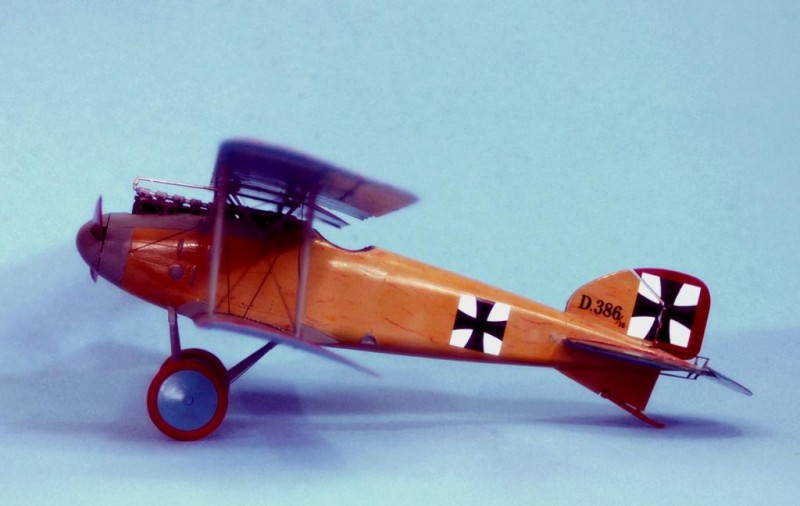
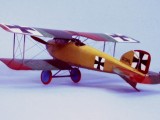

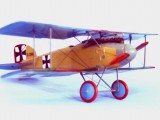

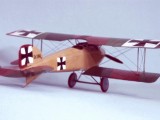
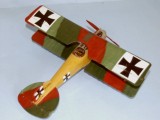

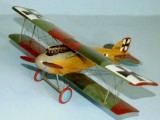

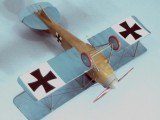
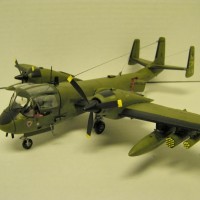
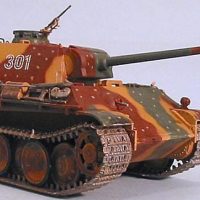
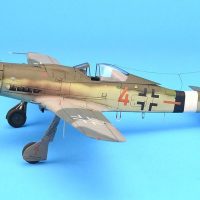
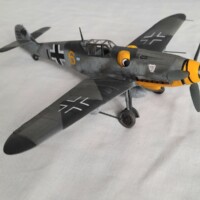
A colourful killer.
Looking at this reminded me of my old 'Aircraft of the Aces' series book on 'Albatros Aces of World War 1' and a few Windsock publications as well, that I've held on to over the years as reference books, and still delve in to from time to time.
The Encore series is basically a Roden kit with some additional resin/etch, and the kits build up nicely. I've built the Bristol Fighter and Fokker tripe, both much cheaper than WNW and still providing excellent detail.
Thanks for an interesting history lesson.
Very nice model too.
🙂 ... Greetings ... 🙂 :
Very nice work on this one Tom, I was very much looking for this one. It turned out GREAT. Thanks for sharing the images, very nice and historical piece.
Nice build Tom. I would love to attempt something with wood grain as I'm seeing all the WW1 builds here, but don't do WW1... It looks like a challenge but those of you who have posted examples recently have done a great job!